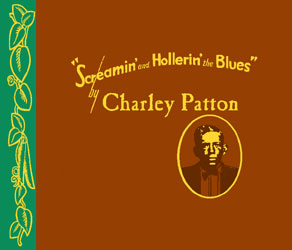 Charley Patton will forever remain as a cornerstone of American music. His contributions to blues are many, being one of the most important figures ever to come from the Mississippi Delta, and his influence on others is unquestioned. Leading the charge before Eddie "Son" House, Robert Johnson, Willie Brown, and many others, he first recorded in 1929 for the Paramount label, and was, in fact responsible for bringing some of those in his "orbit" to the record-buying public at a later date. Charley Patton and that "orbit" are now prominently featured on the incredible 7-CD set from Revenant Records, "Screamin' and Hollerin' the Blues: The Worlds of Charley Patton." Clocking in at over 7 hours of listening time, there are over 100 tracks, including all-known takes of Patton's recordings and sessions he took part in as an accompanist, plus tracks by Willie Brown, Son House, Bukka White, Blind Joe Reynolds, Tommy Johnson, Kid Bailey, and scores more.
Charley Patton will forever remain as a cornerstone of American music. His contributions to blues are many, being one of the most important figures ever to come from the Mississippi Delta, and his influence on others is unquestioned. Leading the charge before Eddie "Son" House, Robert Johnson, Willie Brown, and many others, he first recorded in 1929 for the Paramount label, and was, in fact responsible for bringing some of those in his "orbit" to the record-buying public at a later date. Charley Patton and that "orbit" are now prominently featured on the incredible 7-CD set from Revenant Records, "Screamin' and Hollerin' the Blues: The Worlds of Charley Patton." Clocking in at over 7 hours of listening time, there are over 100 tracks, including all-known takes of Patton's recordings and sessions he took part in as an accompanist, plus tracks by Willie Brown, Son House, Bukka White, Blind Joe Reynolds, Tommy Johnson, Kid Bailey, and scores more.
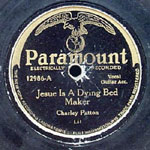 (Jesus Is A Dying Bed Maker -- Courtesy www.secretmuseums.net)
(Jesus Is A Dying Bed Maker -- Courtesy www.secretmuseums.net)
The CD's bear an eerie resemblance to original Patton 78's and are mounted on 10" cardboard cutouts, while stored in reproduction sleeves, making them look pretty close to the originals. This is every bit an historical document, and all gloss and shine aside, barring any future discoveries, it could well be the final word on Charley Patton, a man who has been written about for decades.
 (Dockery Farms / courtesy www.deltablues.net)
(Dockery Farms / courtesy www.deltablues.net)
Born in 1891, in all probability somewhere between Bolton and Edwards, it was the family's move to the Dockery Plantation which would fuel Charley's love of guitar, lack of interest in farming, and ultimately allow him to come under the influence of Henry Sloan, a resident of that same plantation. Sloan, an unrecorded asterisk in blues history, showed the young Charley some chords and fingering patterns, and the rest, as they say, is history. Dockery's was once home to heavyweights like Son House, Bukka White, Willie Brown, and other well-known names in blues. Over a few short years, from 1929 to 1934, Charley Patton recorded some of the strongest blues performances in Delta history, along the way waxing periodic pop-flavored tunes, dance numbers, and religious titles. While seemingly devoted to his trade as a master bluesman, it is also possible that his "worlds" collided as a result of serving both the devil and God. Known to have been a young preacher, Patton knew the Bible well, and according to family members, favored The Book of Revelations, and once went as far as delivering a sermon in the middle of one of his records. Son House was another who, at times, was torn between his love for God and service to his own wallet, playing "the devil's music," and House also preached the Word of God. It comes as no small wonder then, that Patton was utterly convincing in both realms; as a bluesman, he was certainly one of the roughest and most forceful performers to have roamed the Delta, while his religious titles are both stunning and moving.
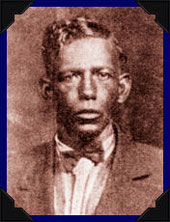 With a voice as rough and gravel-like as the roads he walked and drove, and a guitar style that was incredibly percussive, Charley's recordings have stood the test of time, as has his legend. Considered by his peers, and indeed many scholars, as the founder of Delta Blues, Patton's hierarchy has sometimes been questioned and referred to in a rather off-handed manner by writers. Thought to have been illiterate, and written about by names better left unmentioned, quite the opposite seems fact. His education surpassed what most of his contemporaries had learned, and Patton himself corresponded with H.C. Speir, the talent scout that first brought him to a recording studio. Patton's credibility has previously been challenged too, by those who considered him a reckless drunk, but in order to maintain his high status, he must have been well able to control his alcohol intake.
With a voice as rough and gravel-like as the roads he walked and drove, and a guitar style that was incredibly percussive, Charley's recordings have stood the test of time, as has his legend. Considered by his peers, and indeed many scholars, as the founder of Delta Blues, Patton's hierarchy has sometimes been questioned and referred to in a rather off-handed manner by writers. Thought to have been illiterate, and written about by names better left unmentioned, quite the opposite seems fact. His education surpassed what most of his contemporaries had learned, and Patton himself corresponded with H.C. Speir, the talent scout that first brought him to a recording studio. Patton's credibility has previously been challenged too, by those who considered him a reckless drunk, but in order to maintain his high status, he must have been well able to control his alcohol intake.
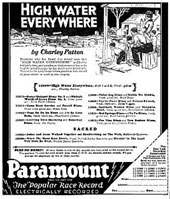 Revenant Records, and the team who gathered around John Fahey for this remarkable set, have leveled the playing field, and rightly so. Patton has, in the past, been ridiculed as someone who lived at poverty's doorstep while trying to do his best in a world slanted against him. Again, the reverse is what comes as truth. As a tenant farmer in Mississippi during the 1920's and 30's, after a long year of backbreaking labor, one was lucky to come out even with a plantation owner who leased his land. Many, if not most times, those without other means of income wound up owing twice what they managed as a wage. Patton escaped the toil of cotton picking, and as a popular traveling musician, he earned a comfortable, if not exorbitant amount of money for a young black man.
Revenant Records, and the team who gathered around John Fahey for this remarkable set, have leveled the playing field, and rightly so. Patton has, in the past, been ridiculed as someone who lived at poverty's doorstep while trying to do his best in a world slanted against him. Again, the reverse is what comes as truth. As a tenant farmer in Mississippi during the 1920's and 30's, after a long year of backbreaking labor, one was lucky to come out even with a plantation owner who leased his land. Many, if not most times, those without other means of income wound up owing twice what they managed as a wage. Patton escaped the toil of cotton picking, and as a popular traveling musician, he earned a comfortable, if not exorbitant amount of money for a young black man.
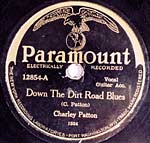 It was his ability to convey the thoughts and feelings of those he sang for which won him such high praise. While not the first performer to sing topical blues, his voice echoed the despair felt by those who purchased his records. His two-part "High Water Everywhere" stands as one of the finest moments in blues history with its chilling account of flood-ravaged lands in 1927, while his "Tom Rushen Blues" and "Jim Lee Blues" were statements of bravery in certainly distressing times for blacks in the South. Patton may be the first bluesman to have used actual characters, names and all, if sometimes in unfavorable terms. In an interesting side note, Patton hand-delivered a copy of "Tom Rushen Blues" to the character himself, and Rushing (correct spelling) held onto the record for many years. He also remembered Charley as an upstanding man.
It was his ability to convey the thoughts and feelings of those he sang for which won him such high praise. While not the first performer to sing topical blues, his voice echoed the despair felt by those who purchased his records. His two-part "High Water Everywhere" stands as one of the finest moments in blues history with its chilling account of flood-ravaged lands in 1927, while his "Tom Rushen Blues" and "Jim Lee Blues" were statements of bravery in certainly distressing times for blacks in the South. Patton may be the first bluesman to have used actual characters, names and all, if sometimes in unfavorable terms. In an interesting side note, Patton hand-delivered a copy of "Tom Rushen Blues" to the character himself, and Rushing (correct spelling) held onto the record for many years. He also remembered Charley as an upstanding man.
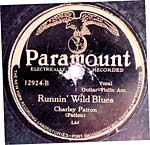 This testament to the genius of Charley Patton was a dream of John Fahey's, and while unfortunate that he didn't live to see its completion, what has been accomplished will certainly allow him to rest easy. Before his death earlier this year, Fahey found a need to reassess Charley Patton, his music, contributions, and longevity. Along with the hours of remastered tracks, which are a work of brilliance, there is a reprint of his 1970 book on Patton, and over 100 pages of newly written material by Dick Spottswood, Edward Komara, David Evans, Fahey, and others, which fills out the package.
This testament to the genius of Charley Patton was a dream of John Fahey's, and while unfortunate that he didn't live to see its completion, what has been accomplished will certainly allow him to rest easy. Before his death earlier this year, Fahey found a need to reassess Charley Patton, his music, contributions, and longevity. Along with the hours of remastered tracks, which are a work of brilliance, there is a reprint of his 1970 book on Patton, and over 100 pages of newly written material by Dick Spottswood, Edward Komara, David Evans, Fahey, and others, which fills out the package.
Upon first delving into Patton's music, you are struck by his harshness as a vocalist and a careening guitar style. Once past the initial shock of hearing him, you can then make attempts to decipher his stentorian lyrics, something that must have taken diligent work by Spottswood. Not only do we have transcriptions of each Patton song, but for each and every track with vocals. And while Patton had been written about as someone who seemed ill-prepared at times for his trips to the recording studio, in the newly-penned liner notes, what is more apparent is that Charley wanted the 'live' feeling of a juke-joint performance to come across in his 78's. Closer listening shows a man with a ventriloquist's talent and the ability to sing a phrase or a few words, then speak in a different voice altogether to emphasize his own points, only to return to his original thoughts as a vocalist. Son House may not have been quite so impressed. It was he who said of Patton, "Charley, he could start singing of the shoe there and wind up singing about that banana."
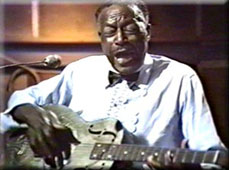 Son House is a strong part of this set with 8 titles, while others of equal stature, though less-recognized, also appear. Willie Brown's chaotic and powerful "M & O Blues" and "Future Blues," both from a 1930 Paramount session are here, as is his Library Of Congress recording of "Make Me A Pallet On The Floor," from 1941. Speculation on Brown is still a matter of discussion as to whether he was an influence on Patton or the other way around. What is pointed out in the notes is that Patton may well have been around first, but it seems as if his talents were eclipsed by Brown's. The Delta Big Four, Walter "Buddy Boy" Hawkins, Louise Johnson, Son Simms, and many more also step in with valuable contributions. A couple of highlights are the Willie Lofton Trio with a throbbing rendition of "Dark Road Blues" from 1935, Blind Joe Reynolds' fierce take of "Cold Woman Blues," ( from a previously unknown surviving 78 recently located in a flea market ), and the "Unknown Convict - Blues" from 1936, while Tommy Johnson's small handful still shine as brightly as they must have some 73 years ago, and with remastered sound, they now sparkle.
Son House is a strong part of this set with 8 titles, while others of equal stature, though less-recognized, also appear. Willie Brown's chaotic and powerful "M & O Blues" and "Future Blues," both from a 1930 Paramount session are here, as is his Library Of Congress recording of "Make Me A Pallet On The Floor," from 1941. Speculation on Brown is still a matter of discussion as to whether he was an influence on Patton or the other way around. What is pointed out in the notes is that Patton may well have been around first, but it seems as if his talents were eclipsed by Brown's. The Delta Big Four, Walter "Buddy Boy" Hawkins, Louise Johnson, Son Simms, and many more also step in with valuable contributions. A couple of highlights are the Willie Lofton Trio with a throbbing rendition of "Dark Road Blues" from 1935, Blind Joe Reynolds' fierce take of "Cold Woman Blues," ( from a previously unknown surviving 78 recently located in a flea market ), and the "Unknown Convict - Blues" from 1936, while Tommy Johnson's small handful still shine as brightly as they must have some 73 years ago, and with remastered sound, they now sparkle.
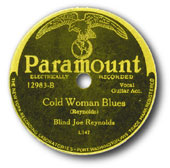 Not everything could be rescued from years of playing on old Victrolas, or neglect, and while there are some tracks that aren't quite what one might hope, the lion's share show painstaking restoration work and dedication on the part of Airshow Mastering, the outfit responsible for retouching the original disks. If the recently-written and informative notes aren't enough by themselves, the crisp and clear sonics we now have on many of the 100+ tracks is a bonus, and the full-page reprints of Paramount advertisements from the Chicago Defender newspaper look stunning. If that doesn't reel you in, maybe the 64 sharply reproduced 78 rpm label stickers from all of Patton's original 78's will be the decision maker, since it's the closest many will get to owning original Patton records. One reviewer of this set mentioned that it seemed almost pornographic to go to this extent to reissue someone's work. But Charley Patton isn't just a 'someone' - he's much more in the long run. And to prove how he's regarded by collectors of his ultra-rare Paramount, Vocalion, and Herwin issues, an original "Masked Marvel" 78 recently brought in a walloping $11,500 at auction! But Patton still doesn't get the respect he's due; that side, "Screamin' And Hollerin' The Blues," was actually listed as "Screamin' and Howlin' the Blues." Paramount records ran a contest when they originally issued the disk by the "Masked Marvel."
Not everything could be rescued from years of playing on old Victrolas, or neglect, and while there are some tracks that aren't quite what one might hope, the lion's share show painstaking restoration work and dedication on the part of Airshow Mastering, the outfit responsible for retouching the original disks. If the recently-written and informative notes aren't enough by themselves, the crisp and clear sonics we now have on many of the 100+ tracks is a bonus, and the full-page reprints of Paramount advertisements from the Chicago Defender newspaper look stunning. If that doesn't reel you in, maybe the 64 sharply reproduced 78 rpm label stickers from all of Patton's original 78's will be the decision maker, since it's the closest many will get to owning original Patton records. One reviewer of this set mentioned that it seemed almost pornographic to go to this extent to reissue someone's work. But Charley Patton isn't just a 'someone' - he's much more in the long run. And to prove how he's regarded by collectors of his ultra-rare Paramount, Vocalion, and Herwin issues, an original "Masked Marvel" 78 recently brought in a walloping $11,500 at auction! But Patton still doesn't get the respect he's due; that side, "Screamin' And Hollerin' The Blues," was actually listed as "Screamin' and Howlin' the Blues." Paramount records ran a contest when they originally issued the disk by the "Masked Marvel."
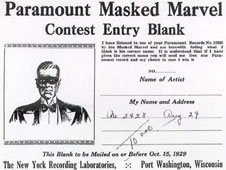 (Reprint of original contest form - notice the number 10,000)
(Reprint of original contest form - notice the number 10,000)
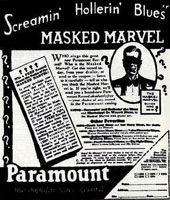 An advertisement was placed in the Chicago Defender in September of 1929 and entry blanks were to be submitted with the name of who the record buyer thought it to be. Since there is no known log from Paramount, just how many records were pressed bearing the "Masked Marvel" moniker is uncertain. The number "10,000" is scrawled on the mock-up of the ad, and some believe that was an order for the number of copies. Even at half that figure, records selling in those amounts was almost unheard of at the time for a Mississippi Delta Blues player. It does, however, help bring into perspective just how popular Patton was with his public. It is also interesting to note how Patton was caricatured in the ads. The man behind the mask resembles a period Hollywood actor!
An advertisement was placed in the Chicago Defender in September of 1929 and entry blanks were to be submitted with the name of who the record buyer thought it to be. Since there is no known log from Paramount, just how many records were pressed bearing the "Masked Marvel" moniker is uncertain. The number "10,000" is scrawled on the mock-up of the ad, and some believe that was an order for the number of copies. Even at half that figure, records selling in those amounts was almost unheard of at the time for a Mississippi Delta Blues player. It does, however, help bring into perspective just how popular Patton was with his public. It is also interesting to note how Patton was caricatured in the ads. The man behind the mask resembles a period Hollywood actor!
In addition to all the extras this set comes with, one CD is devoted to interviews from some who were more than familiar with Patton. There is a short snippet from Howlin' Wolf, who was taught a bit by Charley, a lengthy amount from Patton protégé, Rev. Booker Miller, and H.C. Speir, both interviewed by Gayle Dean Wardlow, and Roebuck 'Pops' Staples, who told Chris Strachwitz that Patton was " a great man." Miller recalls that Charley stayed up all night after having "woman troubles" and that's how he learned to play guitar. He has no memory of Henry Sloan. H.C. Speir seemed to have fond memories of Patton when questioned in 1968.
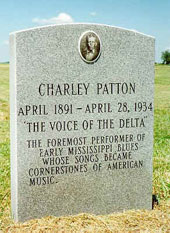 (Patton's grave in Holly Ridge, MS)
(Patton's grave in Holly Ridge, MS)
Charley Patton's place in the annals of blues is well-deserved. This document opens the door completely to show us why. Weighing in at over six pounds, and measuring in at 10" X 12" - it's deserving of lofty placement in the shelves. It's all here... the rude and rhythmic string-snapping of Delta bluesmen. The powerful and haunting voices of Patton, House, Tommy Johnson, and more. The classic sides that somehow get lost in the shuffle of modern releases. This is where it all began... in the Mississippi Delta some seven-plus decades ago. This music lives on and thanks to Revenant Records, John Fahey, David Evans, Gayle Dean Wardlow, and many more, "Screamin' and Hollerin' the Blues: The Worlds of Charley Patton" will find its rightful place as one of the most important documents of Delta Blues.
For more information, the following websites will help: www.revenantrecords.com or www.hatschek.com/pressreleases/airshow-10-10-01.html
Photo/image credits:
"Jesus Is A Dying Bed Maker" photo from www.secretmuseums.net
Dockery Farms from www.deltablues.net
Blind Joe Reynolds label from www.tefteller.com
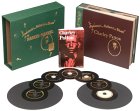 Simply click on the CD cover at left to order this CD NOW!
Simply click on the CD cover at left to order this CD NOW!
This review is copyright © 2001 by Craig Ruskey, and Blues On Stage at: www.mnblues.com, all rights reserved. Copy, duplication or download prohibited without written permission. For permission to use this review please send an E-mail to Ray Stiles.
